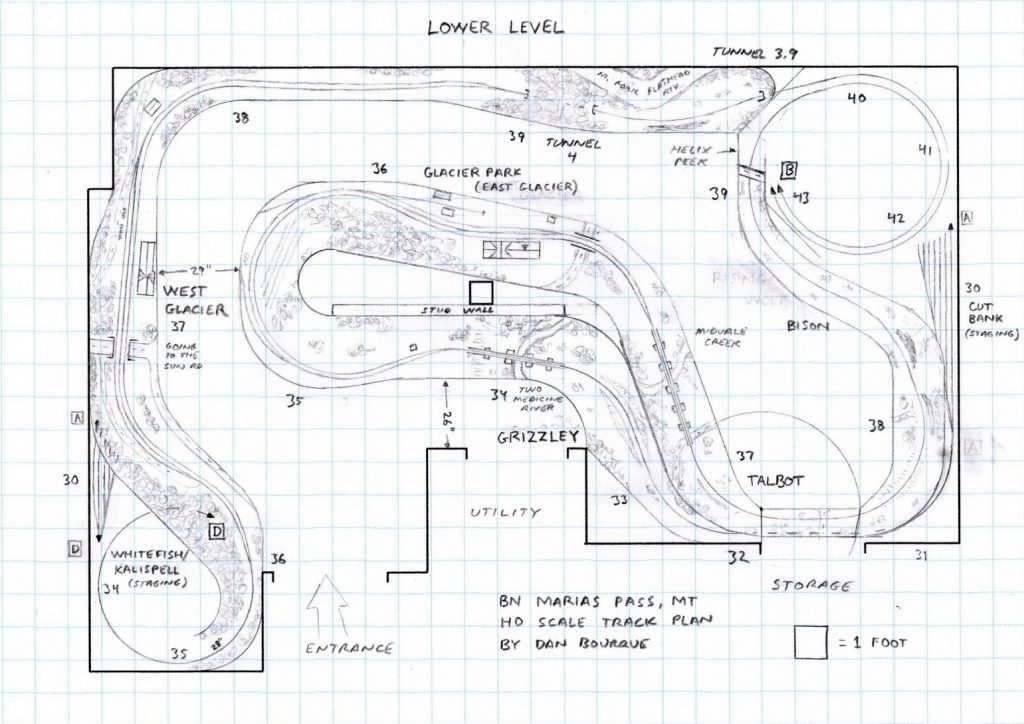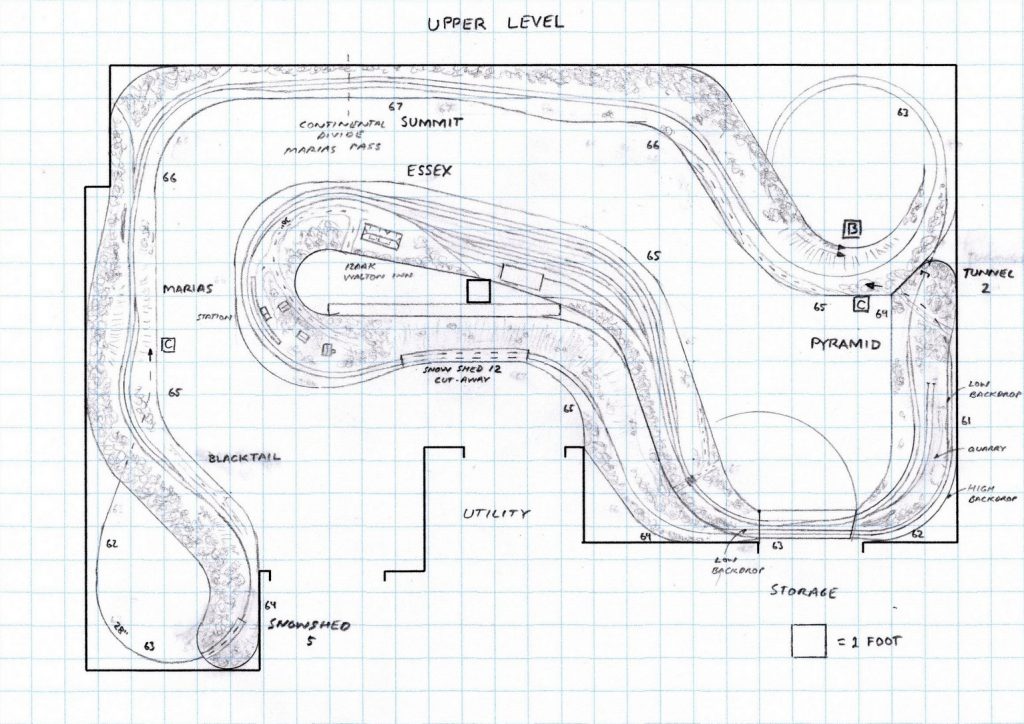- Size: 18′ x 26′
- Scale: HO
- Minimum Radius: 28″
- Minimum Aisle Width: 26″
- Designed by Dan Bourque
This track plan is FAR from the Appalachians, but it captures an iconic piece of mountain railroading, the Burlington Northern’s route over the continental divide via the former Great Northern’s Marias Pass line across the Rockies near Glacier National Park, Montana. This route, the northernmost rail crossing of the continental divide in the US, is known for its snow sheds and incredible glacier-carved backdrops making it the perfect route for Amtrak’s “Empire Builder.”
The Layout
This track plan is designed to fit into a moderate-size basement complete with utility spaces and support poles. This is 50+ miles of railroad on the prototype, so squeezing it into this space was a real challenge. I decided to capture four key vignettes along the route on both sides of the divide including West Glacier, Essex, Summit, and Glacier Park (East Glacier). These areas give a real sense for the different scenery along the way, and they capture the three Amtrak stops along the south side of Glacier National Park. Track arrangements approximate the line during the BN era. I also wanted to keep a “right is east” orientation which is not easy to do on a 4-vignette, 2-level layout. Like the actual route, it’s designed as a down-up-down with West Glacier and Glacier Park anchoring the ends on the lower deck and Essex and Summit on the top deck. This also makes it easy to place staging under the lower deck and limit the amount of hidden track between the ends and staging.
The lower deck starts with a 1.5-turn helix up from west staging (Whitefish/Kalispell) to West Glacier. This vignette captures a long siding, the station at West Glacier, and two tunnels along the Middle Fork Flathead River. This scene is a bit non-traditional as the river is in the background, so scenery slopes down from the aisle to the backdrop. This offers an interesting perspective looking down into the valley, and it begs for a photo backdrop. After entering tunnel 3.9, the line climbs 5 turns in a 2-track helix to re-emerge at Pyramid on the upper deck. Of note, a crew does not have to walk to follow their train, and a narrow “helix peek” allows them to follow their train’s progress through the helix.
At Pyramid, tunnel 2 is slid considerably eastward to hide the exit from the helix. A quarry here is one of the only industries on the line. After crossing a swing-out across a door to storage, the line enters Essex, home to a small yard that was a base for helper operations and MOW equipment. Essex also has a small Amtrak platform on the east side of town. One interesting feature is the plan calls for modeling the Isaak Walton Inn, a trackside feature and railfan favorite with distinct architecture. East of Essex, trains enter the first of many snow sheds on the line. Again, this scene is modeled with the river side toward the backdrop, so I envision the snow shed right up against the aisle offering a cut-away view into the snow shed. From here, the track disappears for a long hidden run around the outside of the room. The track would run along the aisle under Summit and be visible and accessible from the aisle, but a crew would only have to walk 10 feet down the aisle to pick up their train again at Blacktail. In reality this section was all double-track, but there was not sufficient space under Blacktail for two tracks on the turn-back loop, so I made this all single track.
While the prototype grade starts in earnest at Essex, on the layout it really starts under Blacktail and extends to Summit, a tunnel-less and rather non-descript crossing of the divide. While the track plan may look boring here, this area would be ideal for a spectacular photo backdrop of the divide in Glacier National Park to the north. After descending eastward out of summit, the tracks follow a cut into the helix to return to the lower level. Back on the lower level, the trains emerge under an overpass (not prototypical) at Bison. The scenery on the east side of the divide is very different with more prairie-laden hills and stands of trees, but the backdrop is no less spectacular. There are also two tall steel trestles bracketing Glacier Park, both of which are modeled, albeit at a compressed size. Glacier Park itself consists of a passing siding, Amtrak station, and a couple side tracks including the ends of a wye (into the aisle) which appears to be used for loading gondolas now (not during BN era). After crossing the Two Medicine River, the tracks snake through another cut and into east staging (Cut Bank). Staging is envisioned to be 10 tracks with 6 double-ended tracks ~40 feet long along the entire long wall. The shortest siding on the layout is 20 feet, so each track could hold 1-2 trains. The 4 tracks are shorter double-ended tracks under the helix to hold Amtrak trains and locals.
Operations
This layout is designed for the individual who loves mainline trains moving slowly through the mountains. This is a busy main with four passing sidings, so 3-4 operators and a dispatcher would be needed for a full session. The continuous running loop staging yard allows for an unlimited number of trains to be run. Operations would consist of trains of various priorities moving across the layout using sidings as needed for meets arranged by the dispatcher. With around 400 feet of HO-scale mainline between West Glacier and Grizzley, an uninterrupted run at a scale 20 MPH would take a full 22 minutes, so add in a couple of stops, and each train could take between 30 and 45 real minutes to complete its run. Of course, the star of the show would be Amtrak’s Empire Builder hustling over the grade and making brief stops at West Glacier, Essex, and Glacier Park.
Today, distributed power is kept on the train across this entire route eliminating the need for helpers. In the GN and BN eras, manned helper sets pushed heavy trains from Essex to Summit, and it would appear sometimes from West Glacier to Summit. Because of all the hidden trackage between Essex and Summit (and the helix between West Glacier and Essex), this layout would require a modified approach to helpers. The trick would be to “consist” the helpers with the lead locomotives using DCC to mitigate catastrophic results in hidden track. For simpler operations, the helpers could just be left on the train from staging to staging. For more realistic operations, helpers could be cut-in ahead of the caboose in Essex and cut-off at Summit. This would require a “helper crew” operator with an advanced DCC throttle capable of consisting on the main. The helper crew would run the helpers to cut them in at Essex, consist them with the lead locomotives, and then follow the train to Summit where they would “deconsist” the helpers, run around the caboose, and run back downhill to Essex. A local would also be needed to occasionally work the quarry and shuffle a few cars at Essex and Glacier Park.
Because of the long mainline run and time spent adding and removing helpers, a 12-hour session would keep the session length reasonable. It would also limit the need to have 2 full Amtrak consists as an “AM session” would have an eastbound Empire Builder and a “PM session” would have a westbound. Additional variety could be gained by varying the era with F-unit helpers in the ’70s and DPUs in a BNSF era.
Things I Like About This Plan
- Some iconic scenes and scenery
- Consistent “right is east” orientation
- Captures operations of both ends of a mountain summit
- Helpers and passenger trains are cool
- Continuous running option (and infinite staging)
- Great layout for photo backdrops
Things I Don’t Like About This Plan
- Some significant compression within and between scenes
- Lots of hidden track (though reasonably accessible)
- Some narrow aisle pinch-points
- Inability to run “manned” helpers due to hidden track
- Limited number of staging tracks
Related Products:





